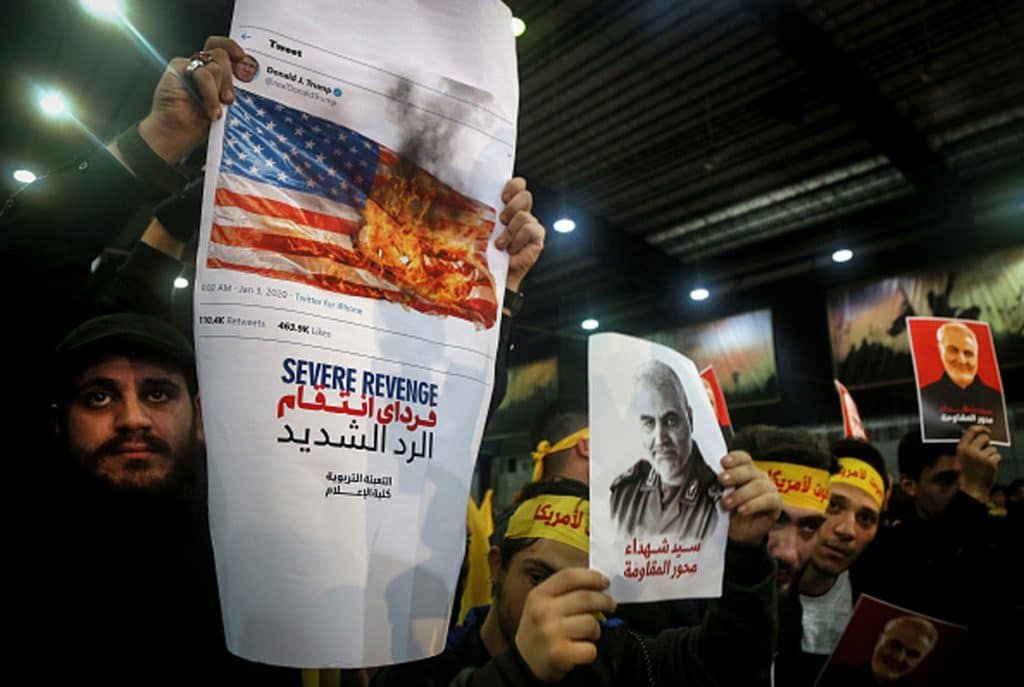What the Soleimani killing means for the Iran nuclear deal
By Abbas Milani | January 5, 2020
 Supporters of Lebanon's Iran-allied Hezbollah movement vowing revenge at a mass rally and televised speech by Hezbollah Secretary-General Hassan Nasrallah in tribute to Qassem Soleimani, commander of the elite Quds Force of the Iranian Revolutionary Guard, and Abu Mahdi al-Muhandis, the deputy head of the predominantly Shia Muslim Popular Mobilization Forces (PMF), who were killed in a US airstrike in Baghdad. (Photo by Marwan Naamani/picture alliance via Getty Images)
Supporters of Lebanon's Iran-allied Hezbollah movement vowing revenge at a mass rally and televised speech by Hezbollah Secretary-General Hassan Nasrallah in tribute to Qassem Soleimani, commander of the elite Quds Force of the Iranian Revolutionary Guard, and Abu Mahdi al-Muhandis, the deputy head of the predominantly Shia Muslim Popular Mobilization Forces (PMF), who were killed in a US airstrike in Baghdad. (Photo by Marwan Naamani/picture alliance via Getty Images)
First came President Trump’s decision to have the United States unilaterally leave the multilateral 2015 nuclear deal with Iran (formally known as the Joint Comprehensive Plan of Action, or JCPOA). It was followed by the policy of “maximum pressure” on the Iranian economy; the rash but momentous decision to assassinate Qassem Soleimani, the commander of the Qods Brigade and easily the second most powerful man in Iran; and the controversial presidential tweet threatening that if Iran took retaliatory action, the United States had already identified 52 targets in Iran, including cultural sites. When Iran’s supreme leader and other Iranian officials threatened harsh retaliation on US military sites, President Trump—taking a page out of his playbook with North Korea—reiterated that should Iran take any action against US assets, he would hit Iran “harder than they have ever been hit before!”
They attacked us, & we hit back. If they attack again, which I would strongly advise them not to do, we will hit them harder than they have ever been hit before! https://t.co/qI5RfWsSCH
— Donald J. Trump (@realDonaldTrump) January 5, 2020
Finally, in the seething cauldron of these escalating tensions, on January 5, Iran announced that it would no longer abide by limits on its nuclear program stipulated in the JCPOA. What practical steps the Iranian government takes in this regard, and how provocative those steps will be, remain to be seen.
For some time, in spite of the US withdrawal, Iran had continued to abide by its commitment to the nuclear deal. This continued adherence was, on the one hand, because Iran hoped to receive from Europe a package of economic relief from US sanctions. Even more important, Iran needed to keep Russia and China in its corner. Too radical a breach of Iran’s nuclear commitment—or departure from Nuclear Non-Proliferation Treaty, as some Iranian officials had hinted—might have forced China and Russia to abandon their support of the regime.
But the US assassination of Soleimani clearly changed Iran’s calculus, and maybe even the dynamics of its relationship with China and Russia.
If there were any tactical gains for the United States in killing Soleimani, they now pale in comparison with the tactical gains—and even potential strategic benefits—that will accrue to the regime in Tehran. The Islamic Republic of Iran might have lost its most important general, but it has already gained strategically. The outpouring of support for Soleimani in Iraq and Iran, part of it obviously organized by the regime, is one important hint of these potential benefits. The regime might savor the moment, accept the advantages it has gained, and avoid escalation. But its own bombast and declared commitment to attack US military assets, and Trump’s repeated threats, are likely to lead to more military confrontation, if not war. These confrontations will play out in what is a rapidly changing context and dynamics.
A first hint of this new dynamic came a few weeks ago when, with great fanfare, Iran celebrated joint naval operations with the Russian and Chinese navies in the Persian Gulf. This is the first time in history that these three countries have organized such joint naval operations. The long-term strategic consequences of a serious Chinese and Russian naval presence in the Persian Gulf is hard to exaggerate. The ill-advised Soleimani assassination seems to have redoubled the Russian and Chinese commitments to consolidate their alliance with the Iranian regime.
The assassination has also helped solve two other urgent problems the Iranian regime faced.
Iran had been encountering increasing Iraqi nationalist protest against its sometimes heavy-handed influence and meddling in that country. Soleimani was often at the center of this controversy. Iranian diplomatic outposts were burnt by angry Iraqi demonstrators. There were economic boycotts of Iranian goods, and statements by Ayatollah Sistani—Iraq’s Iranian-born leader of Shiites—against foreign (read Iranian) interference in Iraqi affairs. Targeting Soleimani has certainly changed the mood in Iraq. The Iraqi parliament just passed a resolution asking the government to end the US military presence in Iraq. Shiite members of the parliament—composing more than half of that body—voted for the resolution, and Sunnis virtually all abstained. Some Shiite factions in Iraq, in and out of the parliament, are even demanding the closure of the US embassy.
A challenge no less significant to the Iranian regime has domestic roots. In response to massive demonstrations against economic hardships—demonstrations that rapidly spread to more than a hundred cities—the Iranian regime moved with shocking brutality, killing several hundred protestors and arresting several thousand.
Supreme leader Ali Khamenei—already under siege by critics for his order to brutally suppress these demonstrations—even drew criticism from his traditional base for mishandling the discontent. The assassination of Soleimani has been a gift to the regime in terms of shifting attention away from these protests.
Always adept at using mass demonstrations to showcase the government’s power and popularity, media have been broadcasting nationalist marches, music, and mourning chants around the clock. The regime and its supporters have used images of hundreds of thousands of Soleimani mourners in the streets of Iranian cities, as a new barometer of national unity—and an argument in favor of the status quo.
In suggesting that its Iraqi proxies attack the US embassy late last month, Iran clearly overplayed its weak hand and underestimated Trump’s willingness to engage in a new military adventure in the Middle East. In its decision to target Soleimani, the United States might also have miscalculated Iran’s ability or resolve to respond. The Trump administration has been essentially moving on the assumption that the Iranian regime is so bereft of legitimacy, so entangled with a failing economy and rising popular discontent, that it could not and would not want to enter into a major war with the United States. Maximum pressure, some in the administration believed, might even lead to regime change. Furthermore Trump’s belief, recently reiterated, that any war with Iran will be very short might have contributed to the acceptance of these assumptions.
Events in the last few days have shown how erroneous those assumptions in both Tehran and Washington were. Unless both sides decide to de-escalate, the United States and Iran are moving toward a dangerous and destructive war that will further dim the waning prospects for a working agreement that will convince Iran it is not in its interest to try to develop a nuclear bomb and will also lessen tensions that have reached a fever pitch with the assassination of Soleimani.
Together, we make the world safer.
The Bulletin elevates expert voices above the noise. But as an independent nonprofit organization, our operations depend on the support of readers like you. Help us continue to deliver quality journalism that holds leaders accountable. Your support of our work at any level is important. In return, we promise our coverage will be understandable, influential, vigilant, solution-oriented, and fair-minded. Together we can make a difference.
Topics: Analysis, Nuclear Risk, Nuclear Weapons














